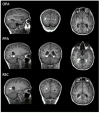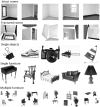The occipital place area represents the local elements of scenes
- PMID: 26931815
- PMCID: PMC4872505
- DOI: 10.1016/j.neuroimage.2016.02.062
The occipital place area represents the local elements of scenes
Abstract
Neuroimaging studies have identified three scene-selective regions in human cortex: parahippocampal place area (PPA), retrosplenial complex (RSC), and occipital place area (OPA). However, precisely what scene information each region represents is not clear, especially for the least studied, more posterior OPA. Here we hypothesized that OPA represents local elements of scenes within two independent, yet complementary scene descriptors: spatial boundary (i.e., the layout of external surfaces) and scene content (e.g., internal objects). If OPA processes the local elements of spatial boundary information, then it should respond to these local elements (e.g., walls) themselves, regardless of their spatial arrangement. Indeed, we found that OPA, but not PPA or RSC, responded similarly to images of intact rooms and these same rooms in which the surfaces were fractured and rearranged, disrupting the spatial boundary. Next, if OPA represents the local elements of scene content information, then it should respond more when more such local elements (e.g., furniture) are present. Indeed, we found that OPA, but not PPA or RSC, responded more to multiple than single pieces of furniture. Taken together, these findings reveal that OPA analyzes local scene elements - both in spatial boundary and scene content representation - while PPA and RSC represent global scene properties.
Keywords: OPA; Parahippocampal Place Area (PPA); Retrosplenial Complex; Scene perception; Transverse Occipital Sulcus (TOS); fMRI.
Copyright © 2016 Elsevier Inc. All rights reserved.
Figures





Similar articles
-
Dissociable Neural Systems for Recognizing Places and Navigating through Them.J Neurosci. 2018 Nov 28;38(48):10295-10304. doi: 10.1523/JNEUROSCI.1200-18.2018. Epub 2018 Oct 22. J Neurosci. 2018. PMID: 30348675 Free PMC article.
-
The occipital place area represents first-person perspective motion information through scenes.Cortex. 2016 Oct;83:17-26. doi: 10.1016/j.cortex.2016.06.022. Epub 2016 Jul 15. Cortex. 2016. PMID: 27474914 Free PMC article.
-
Functional Subdomains within Scene-Selective Cortex: Parahippocampal Place Area, Retrosplenial Complex, and Occipital Place Area.J Neurosci. 2016 Oct 5;36(40):10257-10273. doi: 10.1523/JNEUROSCI.4033-14.2016. J Neurosci. 2016. PMID: 27707964 Free PMC article.
-
Parahippocampal and retrosplenial contributions to human spatial navigation.Trends Cogn Sci. 2008 Oct;12(10):388-96. doi: 10.1016/j.tics.2008.07.004. Epub 2008 Aug 28. Trends Cogn Sci. 2008. PMID: 18760955 Free PMC article. Review.
-
Scene Perception in the Human Brain.Annu Rev Vis Sci. 2019 Sep 15;5:373-397. doi: 10.1146/annurev-vision-091718-014809. Epub 2019 Jun 21. Annu Rev Vis Sci. 2019. PMID: 31226012 Free PMC article. Review.
Cited by
-
Exploring pattern recognition: what is the relationship between the recognition of words, faces and other objects?Cogn Process. 2023 Feb;24(1):59-70. doi: 10.1007/s10339-022-01111-3. Epub 2022 Nov 14. Cogn Process. 2023. PMID: 36376612 Free PMC article.
-
A common neural substrate for processing scenes and egomotion-compatible visual motion.Brain Struct Funct. 2020 Sep;225(7):2091-2110. doi: 10.1007/s00429-020-02112-8. Epub 2020 Jul 9. Brain Struct Funct. 2020. PMID: 32647918 Free PMC article.
-
The occipital place area represents visual information about walking, not crawling.Cereb Cortex. 2023 Jun 8;33(12):7500-7505. doi: 10.1093/cercor/bhad055. Cereb Cortex. 2023. PMID: 36918999 Free PMC article.
-
Selective responses to faces, scenes, and bodies in the ventral visual pathway of infants.Curr Biol. 2022 Jan 24;32(2):265-274.e5. doi: 10.1016/j.cub.2021.10.064. Epub 2021 Nov 15. Curr Biol. 2022. PMID: 34784506 Free PMC article.
-
Common and specific activations supporting optic flow processing and navigation as revealed by a meta-analysis of neuroimaging studies.Brain Struct Funct. 2024 Jun;229(5):1021-1045. doi: 10.1007/s00429-024-02790-8. Epub 2024 Apr 9. Brain Struct Funct. 2024. PMID: 38592557 Free PMC article. Review.
References
-
- Bar M, Aminoff E. Cortical analysis of visual context. Neuron. 2003;38:347–358. - PubMed
-
- Cox RW, Jesmanowicz A. Real-time 3D image registration for functional MRI. Magn Reson Med. 1999;42:1014–1018. - PubMed
-
- De Valois RL, Albrecht DG, Thorell LG. Spatial frequency selectivity of cells in macaque visual cortex. Vision research. 1982;22:545–559. - PubMed
Publication types
MeSH terms
Grants and funding
LinkOut - more resources
Full Text Sources
Other Literature Sources

